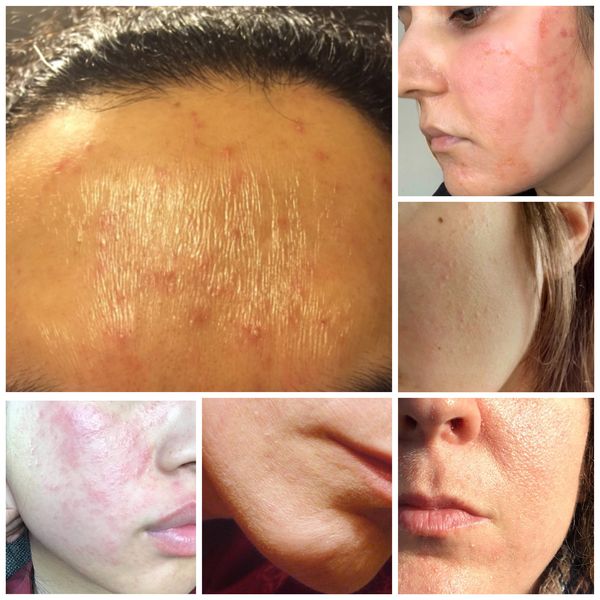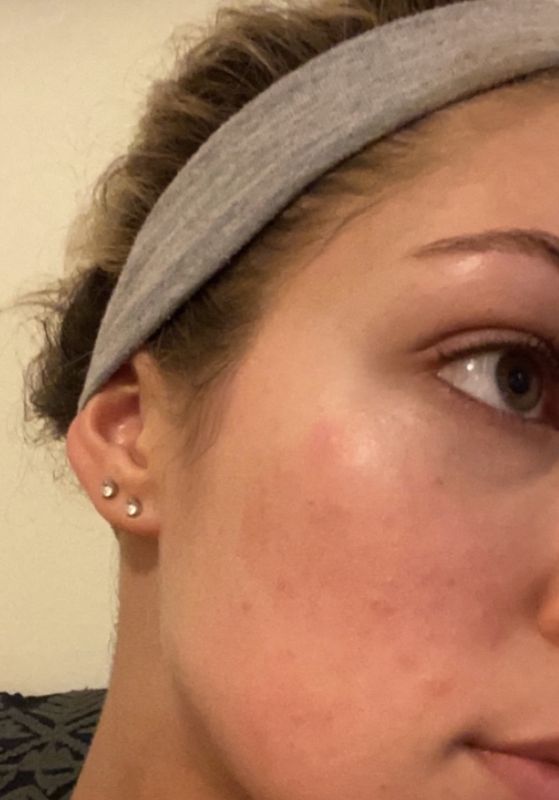Over-exfoliating the skin can lead to a multitude of symptoms, including redness, inflammation, tightness, dryness, flakiness, irritation bumps, rashes, breakouts, and a stinging sensation. With the increasing popularity of at-home chemical exfoliation, it’s easier than ever to go overboard with exfoliating products. This guide will provide you with step-by-step instructions on how to heal over-exfoliated skin overnight and get your skin back to a healthy, radiant state.
Being able to identify when you’ve over-exfoliated is the first step in healing your skin and getting the results that you’re looking for. First, we need to discern the difference between chemical over-exfoliation and physical over-exfoliation.
More from Glowing Gorgeous: Find out here the Best Silicone-Free Moisturizers And Why Do You Care
Understanding Over-Exfoliation
Over-exfoliation can occur through physical or chemical means. Physical exfoliation involves using abrasive tools or products to remove dead skin cells, while chemical exfoliation involves the use of acids, enzymes, peels, and retinols to encourage skin cell turnover.
Physical Exfoliation
Physical exfoliation is classified as using a form of abrasion to remove spent skin cells. It include spin brushes, scrubs, dermaplaning, peel-off masks, and washcloths. Physical exfoliation involves the user to exert some manipulation to the skin in order to remove dead skin. Over-exfoliating through physical means can result in raw, rough-textured, dry, and sensitive skin. It will feel dry, and extra sensitive.
Chemical Exfoliation
Chemical exfoliation works on a deeper level by using acids, enzymes, peels, and retinols to renew skin cells at a faster rate. If used too often, chemical exfoliation can make the skin thin and susceptible to sun damage. Symptoms of over-exfoliation through chemical means include redness, sensitivity, dryness, flakiness, and rough texture.
Chemical over-exfoliation can feel and look like a burn. (some people refer to this as “orange peel skin”). You may notice that the side effects of chemical over-exfoliation seem to linger longer than physical.
How to Avoid Over-Exfoliation
To prevent over-exfoliation, it’s important to follow some key rules and be mindful of your skin’s needs.
Limit Exfoliation Frequency
It’s best to exfoliate only 1-2 times per week to reduce the risk of irritation; this is true for any form of exfoliation. When starting a new exfoliant, perform a patch test (apply a small amount to your inner wrist and wait for 24 hrs to see if you have a negative reaction) and use it only once a week initially. Gradually increase usage as your skin gets accustomed to the product. Even if your skin initially responds well, using the exfoliant too often can still lead to negative side effects.
Keep Your Routine Simple
Any product that works deep within the skin should be used carefully. When introducing a new exfoliant, especially a chemical one, it’s crucial to keep the rest of your skincare routine simple. Introduce the exfoliant as the only new item, one at a time. Focus on using a basic hydrating cleanser, a rich moisturizer, and a sunscreen every day. This allows the exfoliant to work effectively without additional stress on the skin.
Be Gentle with Physical Exfoliation
If you prefer physical exfoliation, choose gentle exfoliating tools and techniques. Also be careful with the amount of pressure you’re using. Avoid harsh scrubs with large granules that can cause micro-tears in the skin. Opt for softer brushes or silicone cleansing devices that provide a gentler exfoliation. Additionally, use light pressure and avoid scrubbing too vigorously.
*Pro Tip: Let the scrub do the work for you- use very, very light pressure and massage in upward circular motions. The same thing goes for spin brushes, washcloths, and other tools. Use them gently, they will still get the job done without excessive pressure!
*Pro Tip: Don’t incorporate a scrub into your routine if you’re trying to treat acne. The two don’t play well together.
More from Glowing Gorgeous: Find out here Hyram’s Recommended Face Sunscreens For The Summer
How to Treat Over-Exfoliated Skin
If you’ve already over-exfoliated your skin and are experiencing irritation and sensitivity, don’t worry. There are steps you can take to help your skin heal overnight.
Aloe Vera for Soothing Irritation
Aloe vera is a natural ingredient known for its soothing and healing properties – it’s an antioxidant with anti-inflammatory properties, it’s great for soothing irritation caused by over-exfoliation. Apply a thin layer of pure aloe vera gel to your over-exfoliated skin. It will help calm inflammation, reduce redness, and provide hydration. You can either use a store-bought aloe vera gel or extract fresh gel from an aloe vera plant.
Its cool temperature and moisturizing properties will keep your skin hydrated and help repair your skin’s barrier. A side effect of over-exfoliation can be excess oiliness to the skin (your skin’s attempt to rehydrate itself after being stripped of healthy oils) so moisturizing more may seem counterproductive. But a rich moisturizer or ingredient like aloe will balance your oil levels and allow your skin to begin its healing process.
*Pro-Tip: Keep aloe vera or your favorite soothing product in your arsenal at all times. You never know when you’re going to have a reaction. Keeping it on hand will prevent you from having to run out with a red face to pick something up!
Importance of Sunscreen
Sunscreen is key for protecting your skin when all is well. When your skin is over-exfoliated, it is overexposed and vulnerable to sun damage more than ever. Sunscreen is an absolute must if you suspect you’ve overdone it. Without it, you are more likely to get a sunburn, hyperpigmentation, and acne scarring. You will NOT want to deal with those things after your over-exfoliation symptoms clear!
Choose a broad-spectrum sunscreen with an SPF of 30 or higher and apply it generously to your face and any exposed areas. Reapply every two hours, especially if you’re spending time outdoors.
Don’t Panic, Let Your Skin Heal
One of the most important things you can do for over-exfoliated skin is to give it time to heal.
Over-exfoliation has happened to the best of us. I made the mistake of thinking my skin was ready for Retin-A AND glycolic acid. I was very wrong! I broke out in an itchy rash, accompanied by redness and whiteheads galore. I followed some of the steps above, and my skin was back to normal in no time.
Avoid using any exfoliating products or treatments until your skin has fully recovered. Instead, focus on a gentle skincare routine that emphasizes hydration and nourishment.
You may be tempted to double up on acne treatments if you experience new breakouts from over-exfoliating. This will set you up for disaster! In school, I was taught that breakouts caused by over-exfoliating need to be killed with kindness.
*Pro-Tip: Don’t let temptation win! Avoid using spot treatments (like salicylic acid or tea tree oil) on breakouts caused by over-exfoliation. Instead, keep your face hydrated and don’t attempt to pop them. Trust that they will go away on their own.
*Pro Tip: If you experience a rash or hives from over-exfoliation, an antihistamine like Benadryl can help. You can also press a cool washcloth on your face to soothe the inflammation and itchiness. Try not to scratch your skin!
Additional Tips for Healing
- Cleanse with a gentle, hydrating cleanser to remove impurities without further stripping the skin.
- Moisturize your skin with a rich, hydrating moisturizer that contains ingredients like hyaluronic acid, ceramides, and soothing botanical extracts.
- Consider using a fragrance-free and alcohol-free product to minimize potential irritants.
- Apply a cool compress to reduce inflammation and provide relief to irritated areas.
- Drink plenty of water to keep your skin hydrated from within.
- Avoid wearing makeup until your skin has healed to prevent further irritation.
OTHER TIPS
Things like only cleansing with tepid water, swapping a foaming cleanser for a cream cleanser, skipping a cleanse in the morning, gently pat your face dry with a soft washcloth, sticking to the basics, and drinking extra water can all help propel the healing process! Baby your skin, because it’s in a very vulnerable state.
Product Recommendations for Over-Exfoliated Skin
Choosing the right skincare products can significantly aid in the healing process of over-exfoliated skin. Here are some recommendations:
Gentle Cleanser
- Dermalogica Special Cleansing Gel – Gentle-Foaming Face Wash Gel
- CeraVe Hydrating Facial Cleanser
- Eau Thermale Avene Gentle Milk Cleanser
Hydrating Moisturizer
- Vichy Aqualia Thermal Rich Face Cream Moisturizer
- Cetaphil Daily Hydrating Lotion
- Drunk Elephant Lala Retro Whipped Cream
Soothing Face Mask
- Origins Drink Up Intensive Overnight Hydrating Mask
- Laneige Water Sleeping Mask
- Mario Badescu Mask
Final Thoughts
Over-exfoliating is a really easy thing to do. It kind of creeps up on you, then you wake up with red, angry skin. Remember to always start slow with exfoliants, and give your skin the time it needs to adjust. If you do happen to experience over-exfoliation, you don’t need to ban your new product. It may become one of your holy grails. Just cease use until your symptoms clear, and try again-this time MUCH slower. You’ll be seeing the results you want before you know it. Results take time, and you don’t want to backtrack by being overzealous!
FAQs
-
How long does it take for over-exfoliated skin to go away?
The healing time for over-exfoliated skin can vary depending on the severity of the damage. In most cases, the skin can recover within a week or two with proper care and avoidance of exfoliants.
-
Can I use spot treatments for breakouts caused by over-exfoliation?
It’s best to avoid spot treatments that contain active ingredients like benzoyl peroxide or salicylic acid until your skin has healed. Focus on gentle skincare to soothe and restore your skin’s barrier.
-
What are the signs of over-exfoliated skin?
Signs of over-exfoliated skin include redness, irritation, sensitivity, dryness, flaking, and a compromised skin barrier.
Parts of this article was taken from Cherie to make it available to all, credit to user @AriEsthetics.
.


 TONYMOLY Aloe Chok Chok Soothing Gel, 8.5 Fl Oz
TONYMOLY Aloe Chok Chok Soothing Gel, 8.5 Fl Oz La Roche-Posay Anthelios 100% Mineral Sunscreen Moisturizer with Hyaluronic...
La Roche-Posay Anthelios 100% Mineral Sunscreen Moisturizer with Hyaluronic...
 Dermalogica Special Cleansing Gel (1.7 Fl Oz) Gentle-Foaming Face Wash Gel for...
Dermalogica Special Cleansing Gel (1.7 Fl Oz) Gentle-Foaming Face Wash Gel for... CeraVe Hydrating Facial Cleanser | Moisturizing Non-Foaming Face Wash with...
CeraVe Hydrating Facial Cleanser | Moisturizing Non-Foaming Face Wash with... Eau Thermale Avène Gentle Milk Moisturizing No Rinse Cleansing Lotion for...
Eau Thermale Avène Gentle Milk Moisturizing No Rinse Cleansing Lotion for... Vichy Aqualia Thermal Rich Face Cream Moisturizer for Dry and Extra-Dry Skin,...
Vichy Aqualia Thermal Rich Face Cream Moisturizer for Dry and Extra-Dry Skin,... Cetaphil Daily Hydrating Lotion for Face, With Hyaluronic Acid, 3 fl oz, Lasting...
Cetaphil Daily Hydrating Lotion for Face, With Hyaluronic Acid, 3 fl oz, Lasting... Drunk Elephant Lala Retro Whipped Cream. Replenishing Moisturizer for Skin...
Drunk Elephant Lala Retro Whipped Cream. Replenishing Moisturizer for Skin... Origins Drink Up Intensive Overnight Hydrating Mask Unisex Mask 2.5 oz
Origins Drink Up Intensive Overnight Hydrating Mask Unisex Mask 2.5 oz LANEIGE Water Sleeping Mask: Visibly Brighten, Boost Hydration, Squalane
LANEIGE Water Sleeping Mask: Visibly Brighten, Boost Hydration, Squalane Mario Badescu Rose Hips Mask for Combination, Dry, Sensitive Skin | Face Mask...
Mario Badescu Rose Hips Mask for Combination, Dry, Sensitive Skin | Face Mask...
Comments